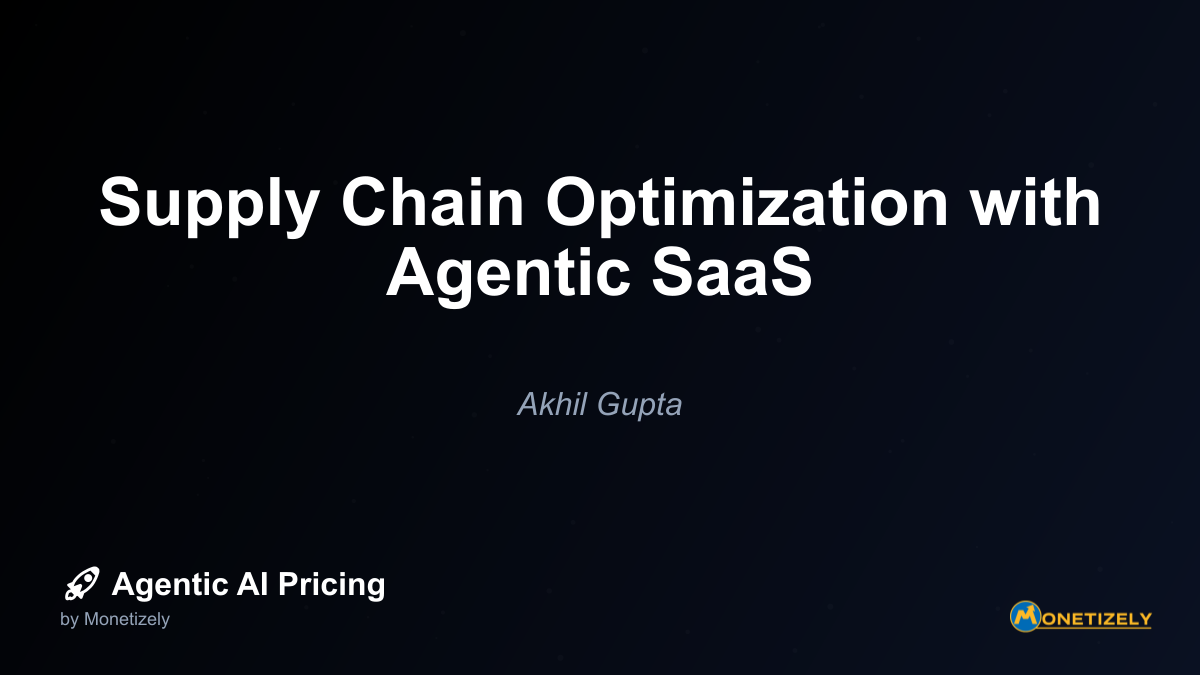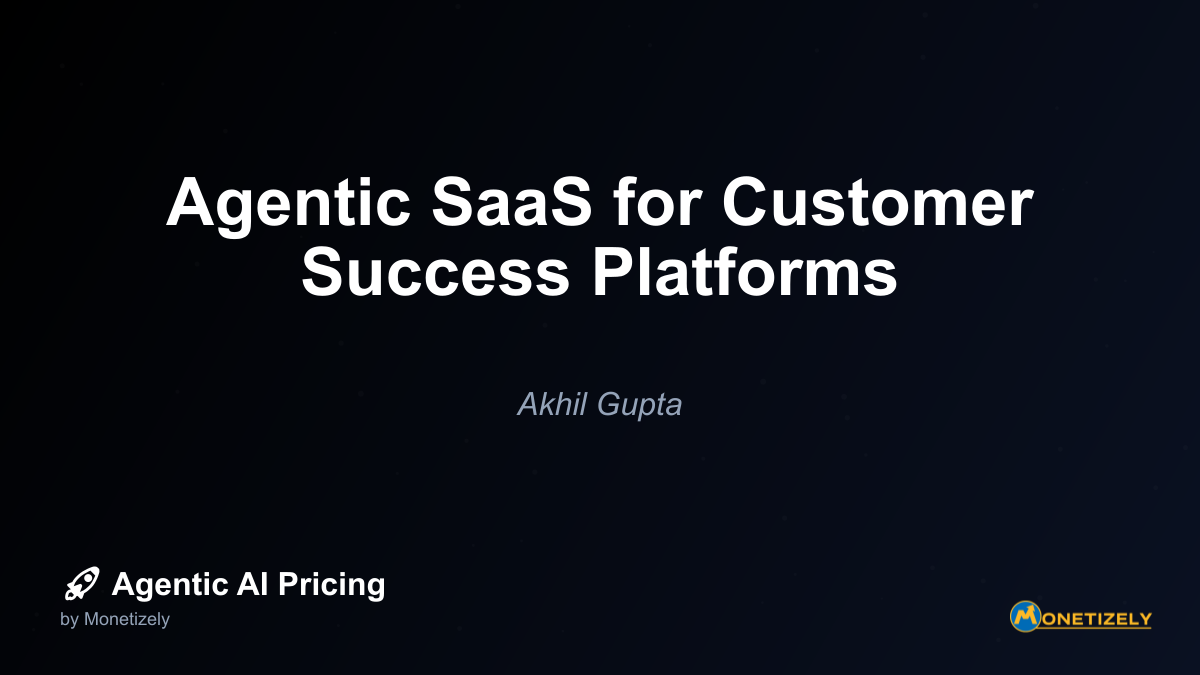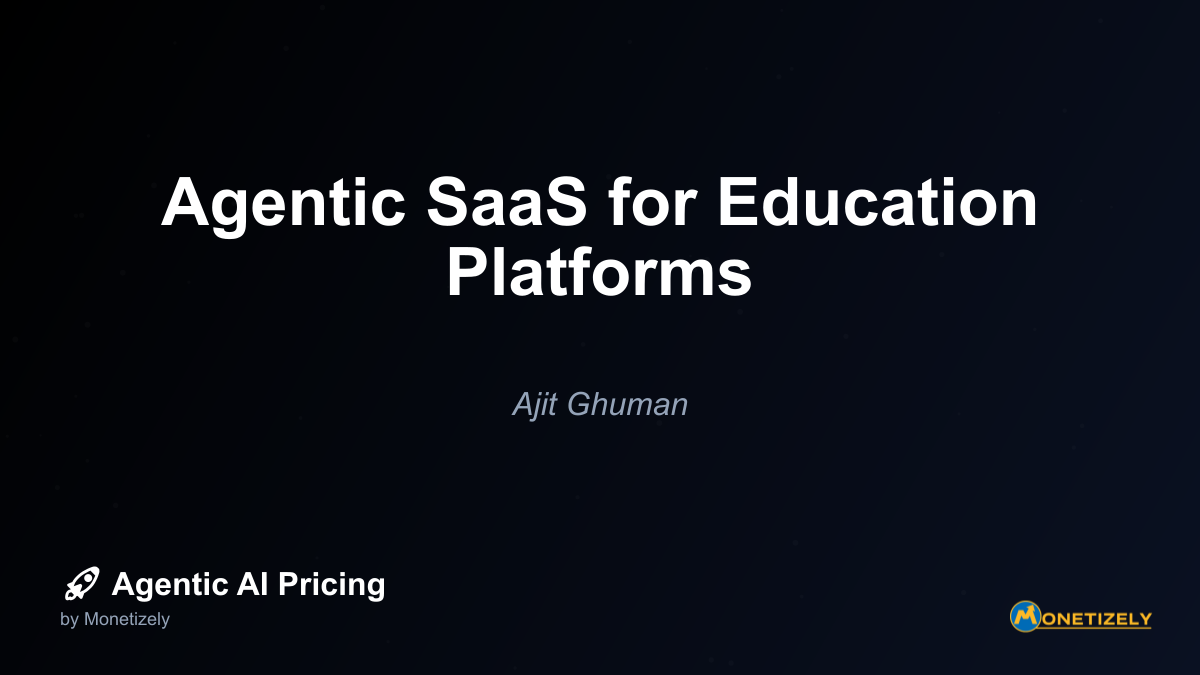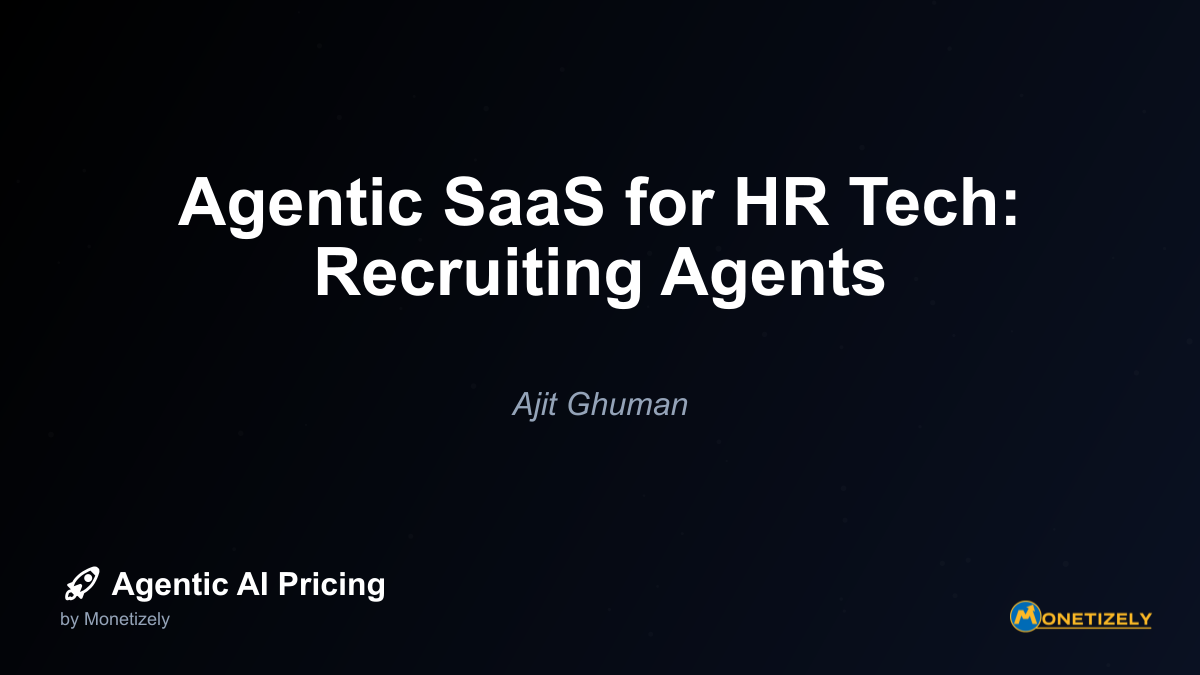· Ajit Ghuman · Vertical Applications · 15 min read
Agentic SaaS in Energy Management
AI and SaaS Pricing Masterclass
Learn the art of strategic pricing directly from industry experts. Our comprehensive course provides frameworks and methodologies for optimizing your pricing strategy in the evolving AI landscape. Earn a professional certification that can be imported directly to your LinkedIn profile.
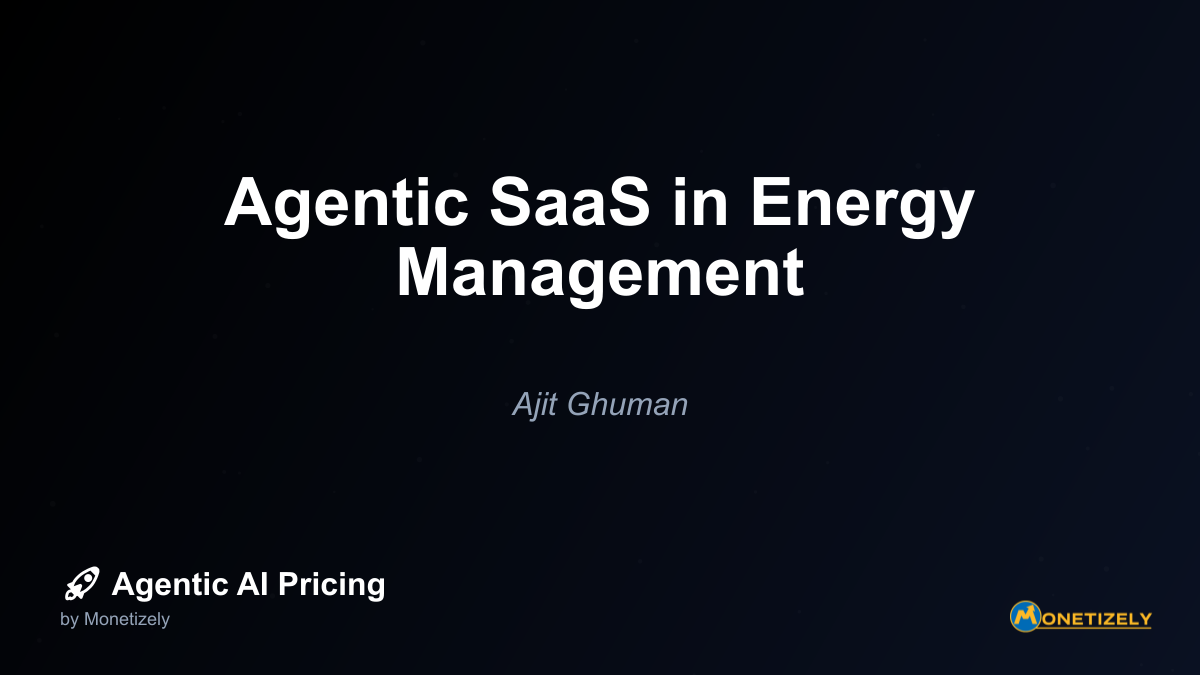
The energy sector stands at the precipice of a significant transformation, driven by the integration of agentic AI into smart grid and utility operations. This revolutionary technology is reshaping how energy is generated, distributed, and consumed, while creating new paradigms for pricing and business models. As utilities worldwide face mounting challenges from renewable integration, grid stability, and evolving consumer demands, autonomous AI agents provide powerful solutions for real-time optimization and management.
The Evolution of Agentic AI in Energy Management
Agentic AI represents a fundamental shift from traditional automation to truly autonomous systems that can observe, decide, and act independently within the energy ecosystem. Unlike conventional AI implementations that require constant human oversight, agentic systems possess the capability to continuously monitor grid conditions, react to changes, and optimize operations without manual intervention.
These autonomous agents excel in environments requiring split-second decisions and complex balancing of multiple variables—precisely the challenges facing modern energy grids. As renewable energy sources grow in prominence, their inherent intermittency creates instability that traditional control systems struggle to manage. Agentic AI thrives in this dynamic environment, making it ideally suited for next-generation grid management.
The market for agentic AI in energy management is expanding rapidly, with a projected CAGR of 36.4% in the coming years. This growth reflects both the urgent operational needs of utilities and the demonstrated value these solutions deliver across the energy value chain.
Core Applications of Agentic AI in Smart Grid Management
Autonomous Grid Management and Real-Time Control
Agentic AI systems continuously monitor grid conditions and react instantly to maintain stability. When renewable energy output fluctuates—for example, when cloud cover reduces solar generation or wind speeds change—AI agents seamlessly shift to backup or stored energy sources to avoid supply disruptions.
Leading utilities have already implemented these capabilities with impressive results. Orsted in Denmark uses autonomous agents to manage wind power output, automatically switching to electrochemical battery storage in milliseconds when generation dips. Similarly, Singapore has deployed city-wide AI-managed energy distribution that dynamically balances demand across districts, optimizing for both efficiency and reliability.
The autonomous nature of these systems represents a fundamental shift from reactive to proactive grid management. Rather than responding to failures after they occur, AI agents anticipate potential issues and take preventive actions, significantly reducing outages and improving overall grid resilience.
Grid Optimization and Load Balancing
Traditional load balancing relies heavily on historical data and manual adjustments, leading to inefficiencies and excess reserve capacity. AI agents revolutionize this approach by analyzing real-time data from smart meters, weather forecasts, and consumption patterns to achieve dynamic equilibrium between supply and demand.
The UK’s National Grid has reported a 33% improvement in forecast accuracy through AI implementation, translating to substantial operational savings and reduced carbon emissions from unnecessary standby generation. This precision allows utilities to operate closer to optimal capacity while maintaining reliability standards.
AI-driven optimization also extends to voltage and frequency regulation, areas where even minor improvements yield significant efficiency gains across the grid. By maintaining these parameters within ideal ranges, utilities reduce energy losses and extend the lifespan of critical infrastructure components.
Predictive Maintenance and Asset Management
Unplanned outages cost utilities millions in repair expenses and lost revenue, not to mention the impact on customers and potential regulatory penalties. Agentic AI transforms maintenance strategies by detecting subtle anomalies in operational data that would be impossible for human operators to identify.
Duke Energy’s AI-powered predictive maintenance program has reduced unplanned outages by 36% through early identification of potential equipment failures. The system autonomously schedules maintenance based on actual equipment condition rather than fixed intervals, optimizing both cost and reliability.
These capabilities extend across the full range of utility assets, from generation facilities to transmission lines and distribution equipment. By continuously monitoring performance parameters, AI agents can distinguish between normal operational variations and early warning signs of impending failures, allowing for precisely targeted interventions.
Renewable Integration and Storage Optimization
The transition to renewable energy introduces significant challenges for grid stability and resource management. Agentic AI addresses these challenges by orchestrating the complex interplay between intermittent generation sources, energy storage systems, and flexible loads.
AI agents autonomously optimize the timing and scale of energy storage dispatch to maximize renewable use efficiency. This reduces curtailment (wasted renewable energy) while enhancing grid reliability. US Department of Energy studies indicate that AI can improve renewable integration efficiency by up to 45%, representing billions in potential savings and accelerated decarbonization.
Storage optimization is particularly critical as battery systems become more prevalent throughout the grid. AI agents determine optimal charging and discharging cycles based on multiple factors including electricity prices, renewable generation forecasts, and anticipated demand patterns. This orchestration maximizes both the financial return on storage investments and their contribution to grid stability.
Intelligent Metering and Consumer Engagement
Smart meters enabled by AI provide utilities and consumers with unprecedented visibility into energy usage patterns. Rather than simply recording consumption, these systems deliver actionable insights and personalized recommendations to improve efficiency and reduce costs.
Iberdrola in Spain has deployed AI-driven smart meters that offer consumers tailored energy-saving advice based on their specific usage patterns. These systems also alert utilities to potential issues such as equipment malfunctions or unauthorized usage, enabling proactive response.
The granular data captured by intelligent metering systems also supports more sophisticated demand response programs, allowing consumers to automatically adjust their consumption based on grid conditions and price signals. This two-way interaction represents a fundamental shift in the utility-customer relationship, transforming passive consumers into active participants in grid management.
Decentralized Energy Market Participation
Perhaps the most transformative application of agentic AI is in enabling automated energy trading and peer-to-peer (P2P) transactions. AI agents can predict price fluctuations, execute trades within milliseconds, and optimize market participation strategies without human intervention.
These capabilities support new energy market models, such as blockchain-enabled P2P solar trading where prosumers (consumers who also produce energy) can sell excess generation directly to neighbors. AI agents handle the complex process of matching buyers with sellers, setting fair prices, and ensuring transaction security.
For larger market participants, AI trading systems optimize bidding strategies across multiple timeframes from real-time balancing markets to day-ahead auctions. These systems continuously learn from market outcomes, refining their strategies to maximize revenue while managing risk according to predetermined parameters.
Technical Architecture for Agentic AI in Energy
Implementing agentic AI for grid management requires a sophisticated technical architecture designed for reliability, security, and real-time performance. Most successful deployments adopt a layered approach:
| Layer | Function |
|---|---|
| Data Acquisition | Collects real-time data from sensors, smart meters, distributed energy resources (DER) |
| Processing | Applies machine learning to identify patterns and predict events (e.g., failures, load spikes) |
| Decision-Making | Uses optimization algorithms to make real-time operational decisions (load balancing, resource allocation) |
| Communication | Ensures seamless, secure interaction between AI agents and grid infrastructure |
| Security | Protects against cyber threats and maintains data integrity |
| Scalability | Supports integration of new resources and technologies |
This architecture is typically deployed via SaaS platforms, enabling utilities to implement AI capabilities without heavy upfront infrastructure investments. The SaaS model also facilitates continuous updates and scalability as energy systems evolve and new technologies emerge.
Edge computing plays an increasingly important role in this architecture, with AI processing distributed throughout the grid rather than centralized. This approach reduces latency for time-critical decisions and enhances resilience by maintaining local intelligence even if communication with central systems is disrupted.
Transforming Utility Pricing Models Through Agentic AI
Beyond operational improvements, agentic AI is fundamentally reshaping how energy is priced and monetized. Traditional fixed-rate tariffs are giving way to dynamic, personalized pricing models that better reflect actual grid conditions and individual consumer behaviors.
Dynamic Pricing Mechanisms
Agentic AI systems analyze real-time data streams including weather forecasts, grid demand, renewable generation levels, and wholesale market prices to dynamically adjust energy prices. Unlike simple time-of-use rates, these AI-driven prices can change in real-time to reflect actual system conditions.
These dynamic pricing mechanisms serve multiple purposes:
- Incentivizing consumers to shift consumption away from peak demand periods
- Encouraging energy use when renewable generation is abundant
- Reducing the need for expensive peaking plants
- Providing more accurate price signals that reflect the true cost of energy at any given moment
The granularity and responsiveness of AI-driven pricing creates more efficient markets while helping utilities manage load and integrate renewables more effectively.
Personalized Tariffs and Customer-Specific Offerings
Beyond system-wide dynamic pricing, agentic AI enables truly personalized tariffs tailored to individual customer profiles. By analyzing consumption patterns, preferences, and behavioral responses, AI agents can design custom rate structures that benefit both the customer and the grid.
For example, a household with electric vehicles might receive preferential rates for overnight charging when grid demand is low. A commercial customer with flexible manufacturing processes could get incentives for reducing consumption during predicted peak periods. These personalized offerings increase customer satisfaction while improving overall system efficiency.
The ability to segment customers and offer tailored products represents a significant shift from the traditional utility model of one-size-fits-all service. AI makes this level of customization economically viable by automating the complex process of designing, implementing, and administering personalized rate structures.
Innovative Business Models
Agentic AI facilitates entirely new business models that would be impossible under traditional utility paradigms:
Savings Share Models: Rather than charging fixed rates, utilities can implement arrangements where they share the financial benefits of AI-driven optimization with customers. For example, if AI reduces a customer’s energy costs by 20%, the savings might be split 50/50 between the customer and the utility.
Energy-as-a-Service: Instead of selling kilowatt-hours, utilities can offer comprehensive energy solutions that include equipment, maintenance, and optimization services, with AI continuously maximizing performance and minimizing costs.
Decentralized Trading Platforms: AI agents enable peer-to-peer energy trading by handling the complex tasks of matching supply with demand, setting fair prices, and managing transaction security, all without human intervention.
These innovative models align incentives between utilities and customers while creating new revenue streams and competitive advantages for forward-thinking energy companies.
Market Trends and Industry Statistics
The energy AI market is expanding rapidly, driven by growing renewable integration, smart grid investments, and regulatory pressure for decarbonization and efficiency. Key statistics illustrate the scale and impact of this transformation:
- Utilities adopting AI-driven predictive maintenance realize 30-40% reduction in downtime and maintenance costs.
- Real-time grid optimization with AI can cut reserve energy costs by 20-30%.
- AI-enabled renewable integration improvements raise clean energy utilization up to 45%.
- The market for agentic AI in energy is growing at a CAGR of 36.4%, reflecting strong demand and proven ROI.
These impressive figures explain why utilities worldwide are accelerating their AI investments despite traditional industry conservatism. The competitive advantages and operational improvements are simply too significant to ignore.
Real-World Case Studies
Orsted (Denmark): Autonomous Wind Farm Management
Orsted has implemented agentic AI to manage the inherent variability of wind power generation. The system continuously monitors output from offshore wind farms and automatically switches to electrochemical battery storage in real-time when generation dips. This autonomous operation maintains grid stability despite fluctuating renewable generation, enabling higher renewable penetration without compromising reliability.
The AI agents handle complex decisions about when to store excess energy and when to dispatch it, optimizing for both economic value and system stability. This capability has been critical to Denmark’s world-leading integration of wind power, which now regularly exceeds 100% of the country’s electricity demand during windy periods.
National Grid (UK): AI-Enhanced Forecasting
National Grid’s implementation of AI-driven forecasting has reduced reserve power requirements by approximately one-third. The system integrates data from weather forecasts, historical consumption patterns, scheduled events, and real-time grid conditions to predict demand with unprecedented accuracy.
This improved forecasting translates directly to operational efficiency, as the utility can maintain smaller reserves while still ensuring reliable service. The environmental benefits are also substantial, as reduced reserve generation means lower carbon emissions and resource consumption.
Duke Energy (USA): Predictive Maintenance
Duke Energy’s AI-powered predictive maintenance program has achieved a 36% reduction in unplanned outages through early identification of potential equipment failures. The system analyzes data from thousands of sensors monitoring critical infrastructure, detecting subtle anomalies that would be impossible for human operators to identify.
By transitioning from scheduled maintenance to condition-based interventions, Duke has optimized both reliability and cost. Maintenance crews are deployed more efficiently, focusing on equipment that actually needs attention rather than performing routine inspections regardless of condition.
Iberdrola (Spain): AI-Driven Smart Metering
Iberdrola has deployed AI-enhanced smart meters that provide customers with personalized energy-saving recommendations based on their specific usage patterns. The system identifies opportunities for efficiency improvements and quantifies potential savings, helping customers reduce both their environmental impact and energy bills.
For the utility, these intelligent meters provide unprecedented visibility into distribution network conditions, supporting proactive maintenance and more efficient operations. The system also detects anomalies that might indicate equipment problems or unauthorized usage, enabling rapid response before minor issues become major problems.
Implementation Strategies and Best Practices
For utilities considering agentic AI implementation, a structured approach maximizes success probability while managing risks and resource requirements:
1. Pilot and Define Use Cases
Start with well-defined pilot projects targeting specific grid challenges such as automated load balancing, predictive maintenance, fault detection, or renewable integration. Establish clear objectives linked to operational efficiency, reliability improvement, or emissions reduction.
Successful pilots build organizational confidence and provide valuable learning that informs broader implementation. They also help identify and address potential issues on a manageable scale before system-wide deployment.
2. Data Acquisition and Integration
Integrate diverse real-time data sources including sensors, smart meters, distributed energy resources, and weather forecasts into a unified system. Ensure data quality, standardization, and appropriate communication protocols for seamless AI operation.
Data is the foundation of effective AI, so this step cannot be overlooked or rushed. Many utilities find that data integration challenges exceed the complexity of the AI implementation itself, particularly when working with legacy systems and equipment.
3. Deploy Layered AI Architecture
Implement a layered architecture that includes data acquisition, processing, decision-making, communication, security, and scalability components. This modular approach facilitates maintenance, updates, and expansion while providing appropriate isolation for critical functions.
Robust cybersecurity measures are essential, as agentic AI systems controlling grid operations represent potential targets for malicious actors. Defense-in-depth strategies with multiple protection layers should be standard practice.
4. Develop KPIs and Monitoring Systems
Define specific energy and operational KPIs such as reduction in peak demand, outage frequency, renewable integration rates, and maintenance costs. Deploy real-time monitoring dashboards that provide transparency into AI decisions and system health.
These monitoring systems serve multiple purposes: they demonstrate the value of AI investments, build operator trust in autonomous systems, and provide early warning of potential issues requiring human intervention.
5. Phased Rollout with Human Oversight
Deploy agentic AI with built-in human-in-the-loop alerting and incident response protocols to balance autonomy with appropriate control. Gradually expand scope from simpler applications like automated fault detection to more complex grid optimization roles as confidence grows.
This phased approach allows operators to become comfortable with AI capabilities while maintaining appropriate oversight. It also provides opportunities to refine algorithms and operational procedures based on real-world experience.
6. Iterative Refinement and Scaling
Continuously monitor performance, collect feedback, and refine AI models and operational procedures. Scale solutions across the grid, adapting to new assets and evolving regulatory or technological landscapes.
AI implementation is not a one-time project but an ongoing process of improvement and expansion. Successful utilities establish dedicated teams responsible for monitoring performance, identifying enhancement opportunities, and implementing continuous improvements.
Challenges and Considerations
Despite the compelling benefits, implementing agentic AI in energy management presents significant challenges that must be addressed:
Technical Complexity and Integration
Integrating AI systems with existing grid infrastructure—much of which was designed decades before AI emerged—requires substantial technical expertise and careful planning. Compatibility issues, data quality problems, and communication limitations can impede implementation.
Successful projects typically involve cross-functional teams combining deep domain knowledge of utility operations with AI expertise. This collaborative approach ensures that technical solutions address actual operational needs while remaining practical to implement within existing constraints.
Cybersecurity Vulnerabilities
As AI systems become central to grid operations, they represent potential targets for cyberattacks with potentially severe consequences. Protecting these systems requires comprehensive security measures including encryption, access controls, anomaly detection, and regular security audits.
The autonomous nature of agentic AI creates additional security considerations, as these systems must be designed to detect and respond to potential compromises without human intervention. Fail-safe mechanisms that default to secure states during suspected attacks are essential components of robust implementations.
Workforce Adaptation and Culture
Implementing AI requires significant changes to workflows, job responsibilities, and organizational structures. Operators accustomed to manual control may resist autonomous systems, particularly in safety-critical environments like energy infrastructure.
Addressing these challenges requires comprehensive change management programs that include training, clear communication about roles and responsibilities, and gradual transition periods where operators can build confidence in AI capabilities. Involving operational staff in implementation planning helps ensure that solutions address their needs and concerns.
Regulatory Uncertainty
Energy utilities operate in highly regulated environments, and many current regulations do not explicitly address autonomous AI systems. This regulatory uncertainty creates compliance risks and potential legal liabilities that must be carefully managed.
Proactive engagement with regulators helps utilities navigate this evolving landscape. By demonstrating transparency, accountability, and robust safety measures, energy companies can help shape appropriate regulatory frameworks while advancing their AI implementations.
The Regulatory Landscape
The regulatory landscape for agentic AI in energy management is evolving rapidly, with implications for implementation strategies and compliance requirements:
Current Regulations
Energy utilities already operate under strict regulatory frameworks concerning grid reliability, safety, and cybersecurity. These existing regulations apply to AI implementations, though they may not specifically address autonomous systems.
Data privacy regulations such as GDPR in Europe and CCPA
Co-Founder & CEO
Ajit is the author of Price To Scale, a top book on SaaS Pricing and is the Founder of Monetizely. Ajit has led and worked in pricing and product marketing at firms like Twilio, Narvar and Medallia. His work has been featured in Forbes and VentureBeat. Ajit regularly consults with software companies from Seed stage to post-IPO on pricing strategy. Ajit is also a highly-rated co-instructor for 'The Art of SaaS Pricing and Monetization' on Maven.
Pricing Strategy Audit
Let our experts analyze your current pricing strategy and identify opportunities for improvement. Our data-driven assessment will help you unlock untapped revenue potential and optimize your AI pricing approach.

